CommonWealth Magazine’s 40th Anniversary Special Tribute: Open · Taiwan
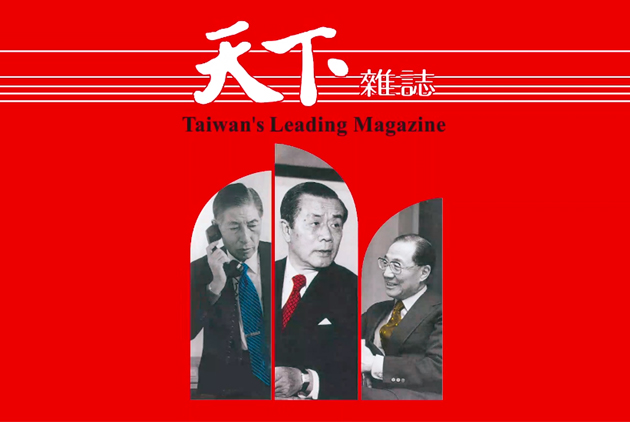
Source:CommonWealth Magazine
2021 is the fortieth year since CommonWealth Magazine was founded in 1981. It is the start of this century’s third decade. It is also year one of post-pandemic recovery. For the next forty weeks, we will showcase a year of CommonWealth Magazine’s history. We will tell the story of our publication and our country during that year.
Views
CommonWealth Magazine’s 40th Anniversary Special Tribute: Open · Taiwan
By CommonWealth Magazineweb only
Over the past forty years, Taiwan has been able to forge a new path and find the light of hope, even in the bleakest moments. It was part luck, part tenacity.
Who were our trailblazers, and who will lead us into the future? Open the doors, we say, on the 40th Anniversary of CommonWealth Magazine: Open the pages of history, open our ongoing dialogue, and open the window of tomorrow.

2021 is the fortieth year since CommonWealth Magazine was founded in 1981. It is the start of this century’s third decade. It is also year one of post-pandemic recovery.
For the next forty weeks, on every weekend, we will showcase a year of CommonWealth Magazine’s history. We will tell the story of our publication and our country during that year.
The decade that opened in 1981 and closed in 1990 was one of loosening restrictions. One by one, the bans on newspapers, political parties, tourism, and banks were lifted. Opened were the shackles of the past, and a freer Taiwan emerged. It experienced unprecedented growth, only to be followed by unforeseen pitfalls.
It was an age when a few visionaries planted the seeds of Taiwan’s future. Their policies were the fertile soil that nurtured growth. They built the infrastructure that enabled the restructuring and transformation of our industries. They also put in place safety nets for our quality of life.
It was an age when tens of thousands of small- and medium-sized enterprises all over Taiwan rolled up their sleeves and got to work. With sweat and toil, with flexibility, efficiency, and low-cost production, they made the products that sold like hot cakes around the world. Foreign currency flooded into Taiwan.
It was also an age when the country almost overdosed on cash. The stock market soared over 10,000 points. The middle-class citizens camped out on Zhongxiao East Road to protest exorbitant housing prices. Taiwan became one giant casino, and the very soul of the country was up for grabs.
Please join us in opening the pages of history, and open your mind to the possibility of a fairer, brighter future.
By Our Own Bootstraps: 1981
Taiwan had just ended diplomatic relations with the United States two years prior. It stood alone on the global stage. The economy was further tanked by the Second Oil Crisis. Prices shot up while trade stagnated. It was harder to find a job back then than it is now. Job postings for mailmen required applicants with middle school education or higher; it had 1,600 openings, but 90,000 hopefuls turned up, many of them had college degrees.
In addition, “Tangwai” (non-Kuomintang) forces challenged the Martial Law, culminating in the infamous “Formosa Incident”.
An air of uncertainty permeated the society.
Neither the country nor its citizens knew what lay ahead. The only refuge was a strong economy. It was what helped Taiwan pull itself up by its bootstraps to soar on the world stage.
In this fateful year, CommonWealth Magazine was founded on the belief that “everyone must understand how the economy works”. It informed the public by speaking plainly and delving deeply into the issues of the day.
It built the bridge of communication between the government and the people; between Taiwan and the world.
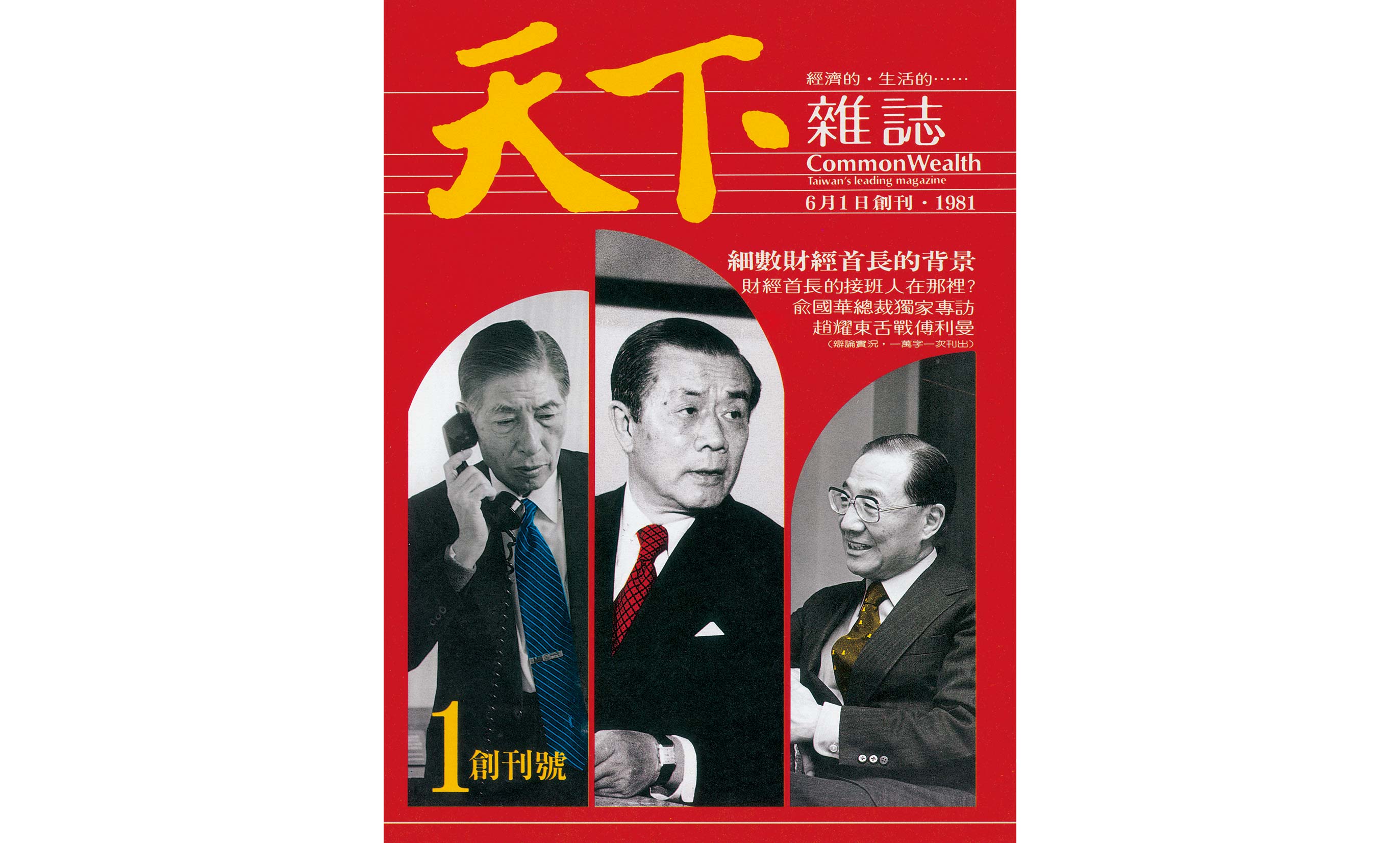
Nowadays, bureaucrats are turning into online celebrities. But under the Martial Law, the public could only perceive government officials and industry leaders through a glass darkly. CommonWealth Magazine pierced the veil of mystery, opening up the lofty halls of government, and, for the first time, the government spoke to the people… (Read More)
Exclusive: A Debate between a Nobel Prize Winner and a Taiwanese Official
The newly founded CommonWealth Magazine featured exclusive reporting on an important policy debate that opened Taiwan’s state-owned enterprises to privatization, Taiwan’s regulations to liberalization and globalization.
In 1981, free market proponent and Nobel Prize winner Milton Friedman visited Taiwan. He engaged in a lively debate with Chao Yao-tung, Chairman of the government darling China Steel and an advocate of a “planned economy”.
The global economy was entering a valley of low growth and high unemployment. Taiwan faced a choice: It could follow the “planned economy” designed by government elites, or it could open the market and let private enterprises engage in free competition. (Read More)
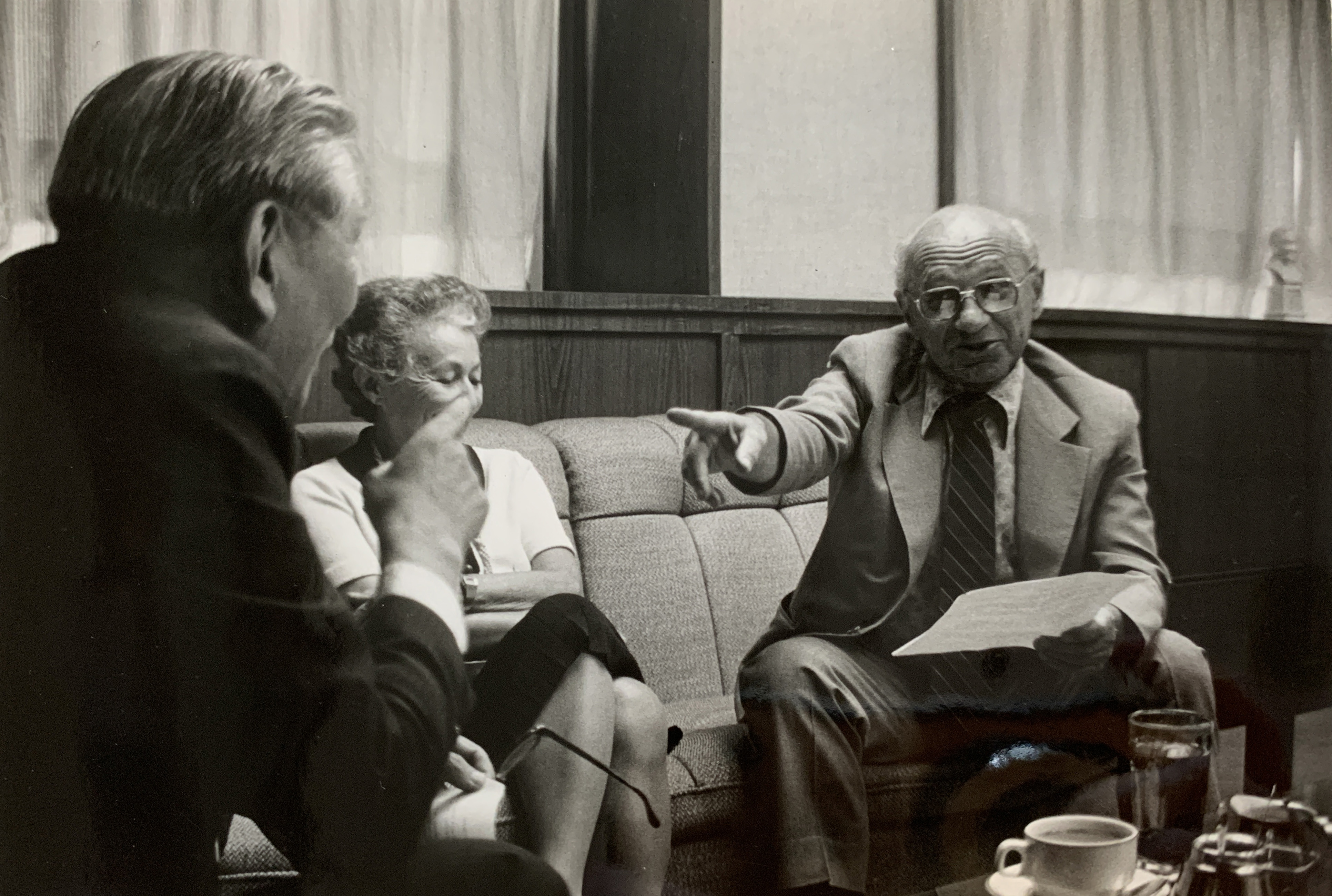 Nobel Prize winner Milton Friedman (R) and China Steel Chairman Chao Yao-tung (L).
Nobel Prize winner Milton Friedman (R) and China Steel Chairman Chao Yao-tung (L).
The “God of Management” Speaks to the Public for the First Time
Under martial law, the average Taiwanese was ill-informed. Not only was the government wrapped in a veil of mystery, even business leaders rarely showed their faces.
CommonWealth Magazine invented the “dialogue” style of reporting. It documented a conversation between Wang Yung-ching, founder and owner of Taiwan’s biggest private enterprise, Formosa Plastics, and Tso-yung Wang, an economist famous for his sharp writing style. The two men discussed whether Taiwan should pursue “prosperity” or maintain “stability”. Should government policies seek to distribute wealth evenly? Or should they focus on nurturing a few elite companies to be Taiwan’s champions on the world stage? It was a “talk show” on paper between a successful entrepreneur and an economic scholar; a policy digest, if you will. (Read More)
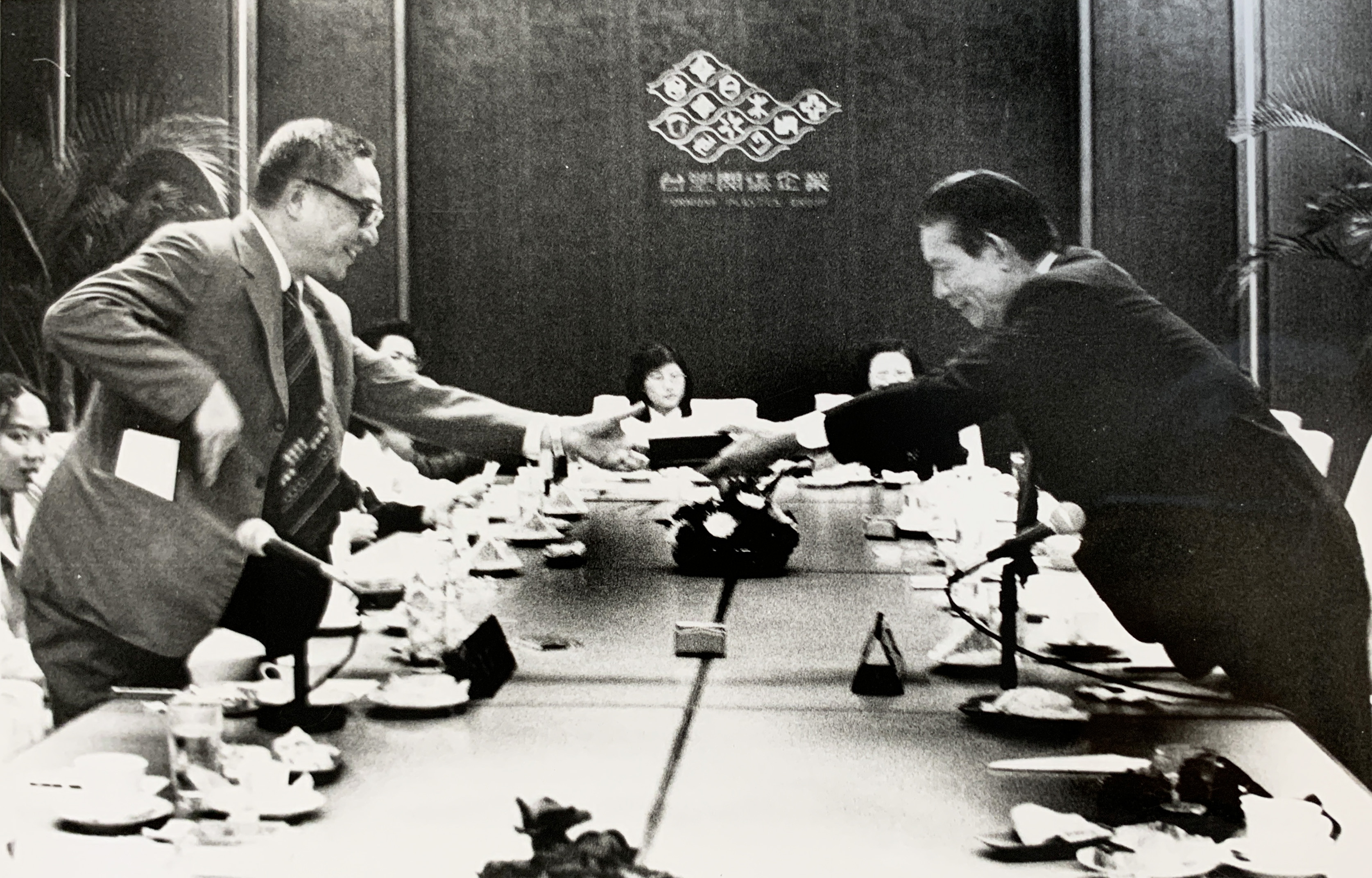
Wang Yung-ching (right), founder of Formosa Plastics Corporation, was Taiwan’s richest man at the time. In multiple surveys of university students, he was the person they most wanted to emulate, their number one “idol”. Tso-yung Wang (left) was a proponent of the “planned economy”. He served as the advisor and ghostwriter of Yin Kwo-yung, a politician credited for securing U.S. aid for the Nationalist government and helping Taiwan’s economy take off after the Chinese Civil War.

“What is management? Management has to be in pursuit of reason, and it must be based in reality. If there is an error in judgement, it must be corrected so it matches reality. Reason, then, is the understanding that what should survive, will survive; what shouldn’t survive needs to be replaced. It is the only way for society to be normal, open, and on the level. We need to find light in the darkness; we must not suffer darkness to become the norm.” -- Wang Yung-ching. (Read More)
The Minister with a Salary of Less than NT$40,000
It was an age when the average wage was low. A government minister made less than NT$40,000 a month. The average salary was NT$12,000. A newly hired factory worker made between five and six thousand. What is the contemporary equivalent of that 40,000-dollar salary of yesteryear? The answer is almost fifty times more. One Taiwanese ping (around 3.3 square meters) of property used to cost around NT$125,000 on Taipei’s Renai Road. Today, a ping in a Renai Road mansion costs almost six million. (Read More)
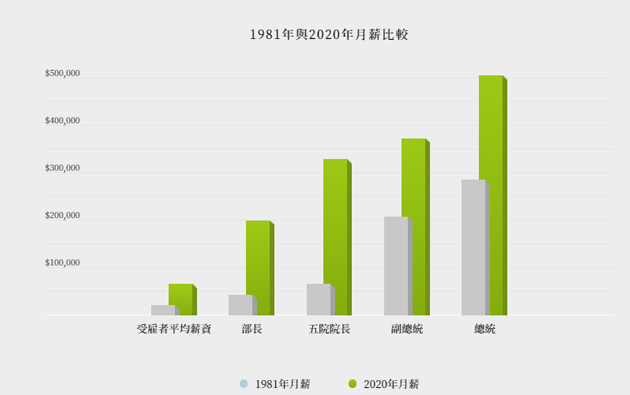
President/ Vice President/ President of a Yuan/ Minister/ Average worker
Gray: Monthly salary in 1981/ Green: Monthly salary in 2019
Taiwan’s Baby Boom of Yesteryear
In those days, not having enough babies was not a problem. Taiwan had the second-highest population density in the world, after only Bangladesh.

Rapid population growth was also an important social issue. Taiwan’s population swelled from eight million after the war to eighteen million. A popular slogan touting population control was “two is enough”.
But beginning that year, Taiwan’s birth rate started an inexorable decline. The number of babies born each year fell from 410,000 to 170,000.
Diagram: In 40 years, the number of Taiwan newborns decreased by nearly 60%
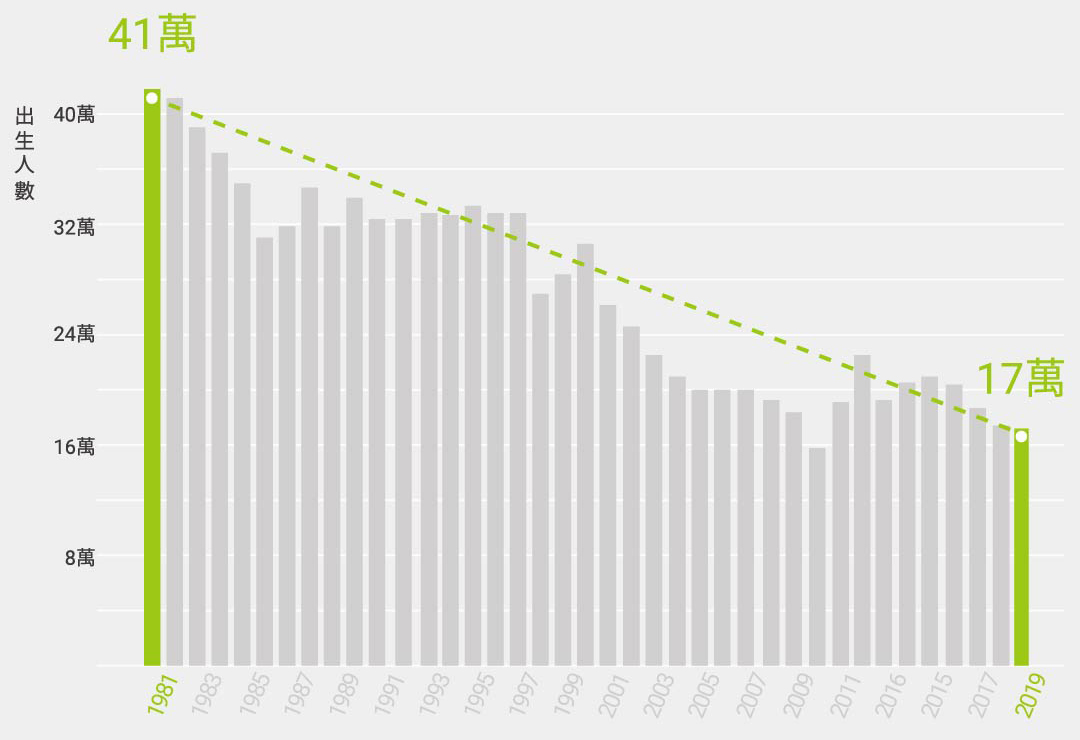 Annual births fell from 410,000 to 170,000.
Annual births fell from 410,000 to 170,000.
Number of births
Have you read?
♦ Formosa Plastics’s Circular Economy Legacy: Turning Decay into Magic
Translated by Jack Chase
Edited by TC Lin
Uploaded by Penny Chiang






